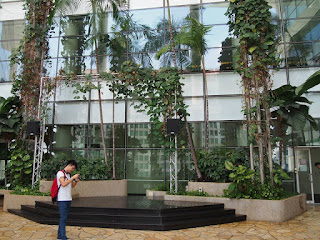What is solar energy? It is using a range of ever-evolving technologies such as solar heating, solar thermal energy, solar architecture and artificial photosynthesis by radiant light and heat from the Sun. It is an important source of renewable energy which won't generate any impact to the environment, the large magnitude of solar energy available makes it a highly captivating source of electricity.
"Singapore's Sports Hub marks new dawn for solar industry"
This short article I stumble upon is about the National Stadium able to stay cool due to the energy provided by the hub's massive solar installation. Singapore is a country enjoys relatively sunny skies all year round, the solar sector can absorb massive solar energy and used to power the stadium's cooling system which will reduce carbon dioxide emissions of at least 367,250 kilograms per year, according to Phoenix Solar.
Solar panels are installed to the stadium's bowl cooling system
Solar power system able to originate clean, pure energy from the sun, it is affordable and sustainable way to generate electricity. Solar reduces air pollution when generating electricity whereby no greenhouse gasses emission from the solar panels. Carbon dioxide and methane emissions from fossil fuels leading contributors to global warming, decreased the air quality and make an impact to human's health. We have to plan for our future generations and prevent stepping towards mitigating the human impact of climate change.
As an architecture student, I think that it is important to integrate solar system with buildings. A successful designer not only design a functional and nice appearance building, it has to be sustainable as well. Shading system such as louvers or curtain walls can be the shade of the facade from excessive light, thus it can absorb heat from the sun and create energy supply to the building.
A 3D zig-zag facade of horizontally sliding solar protection elements made of metallic fabric, by Dominique Perrault Architecture, Paris.
High rise building with solar panels as facade, Germany
In conclusion, the cost of finding and extracting sources will resulting damage to financial infrastructure and environment may not be repairable. Therefore, integrating solar system in a building not only helps to save cost, but it benefits the environment as well. It is the best way to shield against the reality of finite fuel resources.
References:
https://www.svssolutions.com/blog/three-environmental-benefits-solar-energy
http://www.solarcity.com/residential/benefits-of-solar-energy
http://volumatrixgroup.com/?p=2945
http://www.commercialarchitecturemagazine.com/wp-content/uploads/1605pjgkd01popto.jpg
http://img.archiexpo.com/images_ae/photo-g/49576-8429479.jpg
http://www.eco-business.com/news/singapores-sports-hub-marks-new-dawn-for-solar-industry/






















